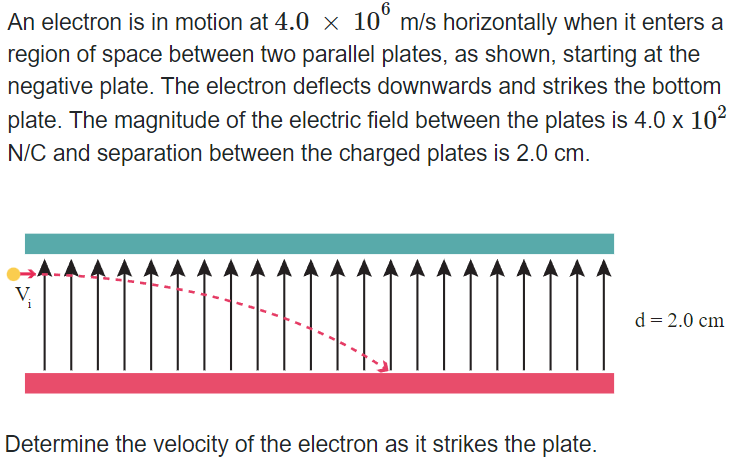An electron is in motion at 4.0 × 10⁰ m/s horizontally when it enters a region of space between two parallel plates, as shown, starting at the negative plate. The electron deflects downwards and strikes the bottom plate. The magnitude of the electric field between the plates is 4.0 x 10² N/C and separation between the charged plates is 2.0 cm. V ΑΛΛΛΛΛΛΑ AA A Determine the velocity of the electron as it strikes the plate. d = 2.0 cm
An electron is in motion at 4.0 × 10⁰ m/s horizontally when it enters a region of space between two parallel plates, as shown, starting at the negative plate. The electron deflects downwards and strikes the bottom plate. The magnitude of the electric field between the plates is 4.0 x 10² N/C and separation between the charged plates is 2.0 cm. V ΑΛΛΛΛΛΛΑ AA A Determine the velocity of the electron as it strikes the plate. d = 2.0 cm
Physics for Scientists and Engineers, Technology Update (No access codes included)
9th Edition
ISBN:9781305116399
Author:Raymond A. Serway, John W. Jewett
Publisher:Raymond A. Serway, John W. Jewett
Chapter24: Gauss’s Law
Section: Chapter Questions
Problem 24.46P: A thin, square, conducting plate 50.0 cm on a side lies in the xy plane. A total charge of 4.00 108...
Related questions
Question
100%
I do not understand why the resultant vector doesn't have θ calculated as the angle made by the electron hitting the bottom plate. I found θ = tan-1 (1.7x106 /4x106 ) = 23°. Is this a misunderstanding and it should be 90°?
vf=4.35x106 [R23°D]

Transcribed Image Text:An electron is in motion at 4.0 × 10⁰ m/s horizontally when it enters a
region of space between two parallel plates, as shown, starting at the
negative plate. The electron deflects downwards and strikes the bottom
plate. The magnitude of the electric field between the plates is 4.0 x 10²
N/C and separation between the charged plates is 2.0 cm.
1
AAAAA
Determine the velocity of the electron as it strikes the plate.
d = 2.0 cm
Expert Solution
This question has been solved!
Explore an expertly crafted, step-by-step solution for a thorough understanding of key concepts.
This is a popular solution!
Trending now
This is a popular solution!
Step by step
Solved in 2 steps with 2 images

Knowledge Booster
Learn more about
Need a deep-dive on the concept behind this application? Look no further. Learn more about this topic, physics and related others by exploring similar questions and additional content below.Recommended textbooks for you

Physics for Scientists and Engineers, Technology …
Physics
ISBN:
9781305116399
Author:
Raymond A. Serway, John W. Jewett
Publisher:
Cengage Learning

Physics for Scientists and Engineers with Modern …
Physics
ISBN:
9781337553292
Author:
Raymond A. Serway, John W. Jewett
Publisher:
Cengage Learning

Principles of Physics: A Calculus-Based Text
Physics
ISBN:
9781133104261
Author:
Raymond A. Serway, John W. Jewett
Publisher:
Cengage Learning

Physics for Scientists and Engineers, Technology …
Physics
ISBN:
9781305116399
Author:
Raymond A. Serway, John W. Jewett
Publisher:
Cengage Learning

Physics for Scientists and Engineers with Modern …
Physics
ISBN:
9781337553292
Author:
Raymond A. Serway, John W. Jewett
Publisher:
Cengage Learning

Principles of Physics: A Calculus-Based Text
Physics
ISBN:
9781133104261
Author:
Raymond A. Serway, John W. Jewett
Publisher:
Cengage Learning

Physics for Scientists and Engineers: Foundations…
Physics
ISBN:
9781133939146
Author:
Katz, Debora M.
Publisher:
Cengage Learning


College Physics
Physics
ISBN:
9781305952300
Author:
Raymond A. Serway, Chris Vuille
Publisher:
Cengage Learning